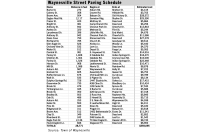It’s that time again
By Kathleen Lamont
The tradition of New Year’s Resolutions can be accurately traced to 153 B.C., although it could go back even further. At that time Janus, a mythical king of early Rome, was placed at the head of the calendar.
Since Janus had two faces, he could look back on past events and forward to the future and thus became the ancient symbol for resolutions. Although the date for New Year’s Day is not the same in every culture, it’s always a time for celebration and for certain customs to guarantee good luck in the coming year.
And Janus ensured that those customs would include the ever-present New Year’s Resolution. You know the old drill: Lose weight, quit smoking, change careers, make more money, and get organized. Well, it’s time to get off the NYR hook — you’re doing most of this all year long anyway, so let’s start a new tradition. At the beginning of each year we perk up our cooking skills and learn to prepare healthier dishes for the family.
Here’s the new drill: Each month learn the ingredients of one of your favorite processed food items and learn to prepare a meal with something you’ve never tried before. Our purpose here is to get smart about what we are eating and take back our power over our health, all the while boosting our immune system.
Over the years I trusted the evolution of processed food and the end product of industrial feed lots. But alas, the industrial food model is coming home to roost. A while back I came upon a most enlightening cookbook that explained the history of some of these processes and shed light on cooking smarter and healthier.
Published in 1995, Nourishing Traditions is a cookbook authored by Sally Fallon (President of The Weston A. Price Foundation, www.westonaprice.org) and others, which claims as its by-line: The cookbook that challenges politically correct nutrition and the diet dictocrats. And it’s a good read as well. Not only is it chock full of healthy nourishing recipes, throughout the book Sally shares the associations between certain foodstuffs and disease, and the actual processes that take place which produce certain unnatural food stuffs.
For instance, let’s take margarine. Margarine has been around for hundreds of years and has a history of a long and bitter struggle with the dairy industry (visit http://en.wikipedia.org/wiki/Dairy_industry), which has defended itself from the margarine industry with vigor. As early as 1877 (http://en.wikipedia.org/wiki/1877), the first states had passed laws to restrict the sale and labeling of margarine. By the mid-1880s, the United States federal government had introduced a tax of two cents per pound, and devotees needed an expensive license to make or sell the product. More importantly, individual states began to require the clear labeling of margarine, banning passing it off as real butter.
The term “shortening” can be used more broadly to apply to any fat, such as butter, lard or margarine, used in baking, but as used in recipes it refers to a hydrogenated vegetable oil that is solid at room temperature. Full hydrogenation results in saturated fats only, but partial hydrogenation will lead to the formation of trans-fats which is an artery-clogging fat found in many other foods besides margarine and shortening, including french fries and fried chicken, doughnuts, cookies, pastries and crackers. In the United States, typical french fries have about 40 percent trans fatty acids and many popular cookies and crackers range from 30 to 50 percent trans fatty acids. Essentially, trans-fats are neither required nor beneficial for health.
For your first foray into cooking with new foodstuffs, why not give quinoa (KEEN-wa) a try. Quinoa comes from the Andes Mountains of South America and its origins are truly ancient. It was one of the three staple foods, along with corn and potatoes, of the Inca civilization. Quinoa was known then and still is known with respect as the mother grain. It contains more protein than any other grain, an average of 16.2 percent compared with 7.5 percent for rice and 14 percent for wheat. It’s protein content is complete with an essential amino acid balance similar to milk. It can be found in the bulk section of any healthy grocery store, such as Earth Fare, French Broad Food Co-op, or Greenlife Grocery, all located in Asheville.
Following is a recipe for a hot breakfast meal using quinoa:
• 2 cups water
• 1 cup quinoa
• 12 cup raisins
• 1 chopped apple
• dash of cinnamon
Place ingredients in saucepan, bring to boil, simmer for 15 minutes. Top with milk and maple syrup. Four servings.
Give this new suggestion a chance. It is said that successful people aren’t those who set a goal and reach it. They’re people who plan well, learn from their mistakes and set new goals just beyond their reach. They also persevere. I wish you an abundance of happiness, health, and perseverance in 2007.
(Kathleen Lamont is a local organic gardener and owner of www.BacktoBasicsNC.com. She can be reached at This email address is being protected from spambots. You need JavaScript enabled to view it..)





